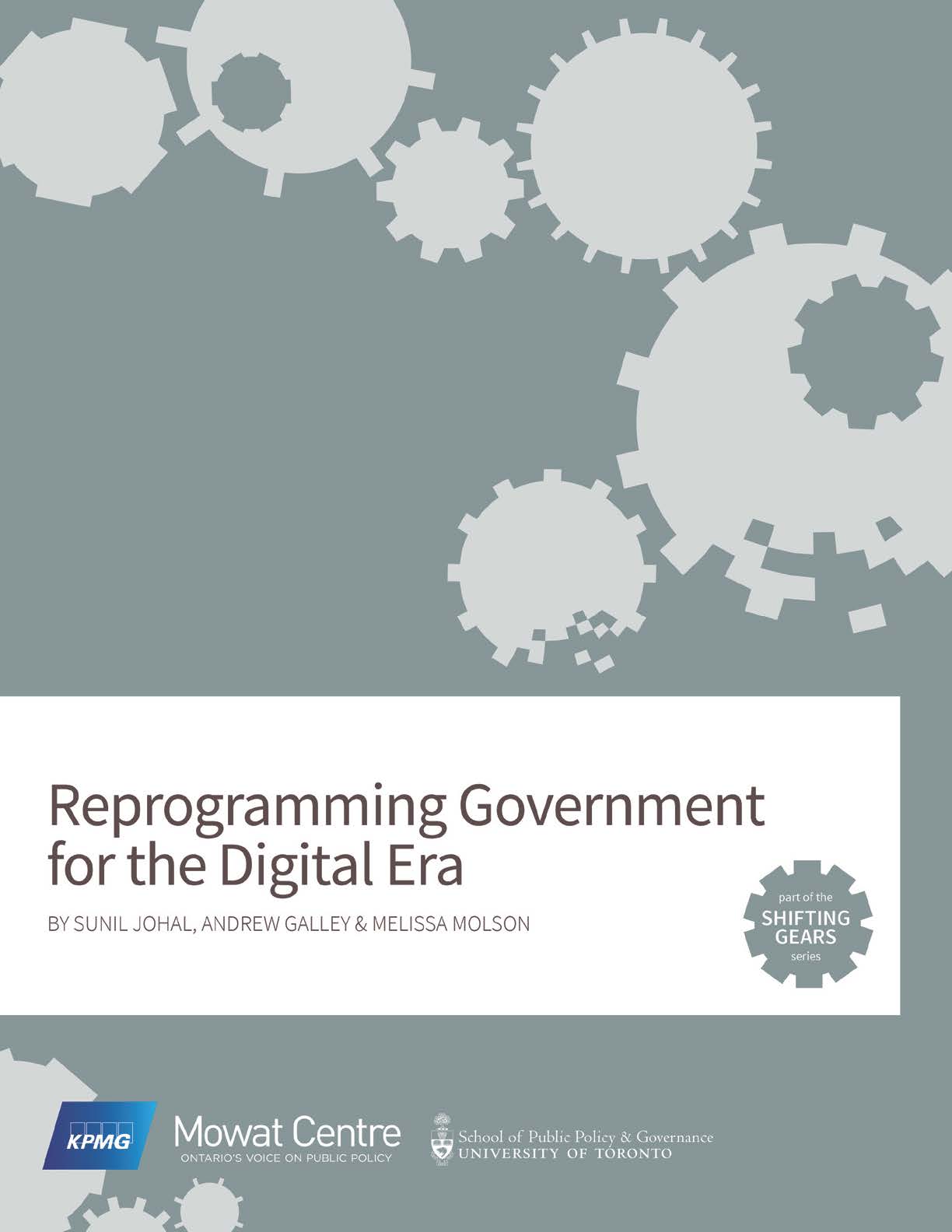November 11, 2014
This Shifting Gears report explores the promise and perils of digital technologies for the core functions of governments.
Executive Summary
The Shifting Gears series reviews the trends and challenges facing governments in delivering high-quality public services in times of fiscal constraint. Today’s public servants face a challenging operating environment. Governments are implementing ambitious reforms to service delivery models and administrative systems, while also undertaking short-term cost cutting and revenue raising measures. Yet this agenda also presents government with a significant opportunity to re-envision a public service for the 21st century. Transformative efforts—aimed at providing better quality services with fewer resources—are coalescing around a number of broad trends:1
- the move to citizen-centred services re-designed around the needs of the end user.
- the sharing of responsibility for policy development and service delivery with new partners from the private and not-for-profit sectors.
- the adoption of new digital technologies that lower transaction costs and respond to evolving citizen expectations of how to interact with government.
- the integration of operations both within and across government departments.
- the evaluation of services on the basis of outcomes rather than process or method.
Furthermore, citizens living in a digital era demand increased transparency about government decisions, what services are available to them and for government-held data. However, the current structures and processes of Canadian governments were not designed to deliver upon these objectives and demands.
Many of the structures and processes governments employ for key functions are rooted in the 19th century, with incremental, ad hoc adjustments to reflect technological advancements. For much of the past 150 years, those incremental changes were sufficient—but, the pace and nature of technological change in the past 20 years demands a more comprehensive reassessment of how governments discharge their core functions. Transforming a government designed for agrarian and industrial ages to operate in the digital age is not simple.
Continue Reading
Governments are now grappling with the next phase of digitization2—fundamentally transforming long-standing service delivery models and processes to account for the opportunities offered by emerging digital technologies in areas such as big data, social media, the internet of things and mobile computing. These new advances offer great promise to governments, whether as means of better engaging citizens and co-developing solutions, having instantaneous feedback loops between program delivery and policy development, gleaning new insights from vast swaths of data or providing significantly more convenient and efficient delivery of services.
Digitization provides an opportunity to deliver more citizen-centred, collaborative, integrated services in a manner that measurably improves outcomes. But many of the benefits offered by digitization—more openness, speed and transparency—are fundamentally at odds with the watchwords of our traditional system of government: confidentiality, hierarchy, and ministerial accountability. We can’t achieve the vision of a 21st century public service without re-thinking the structures, processes and culture of government, with digitization as a critical enabler and catalyst for change.
While the core functions of government remain the same—design effective policy, deliver services efficiently and evaluate rigorously—how governments undertake and execute those functions in a more complex, fast-moving and inter-connected world must change. Digitizing transactions was relatively straightforward—a technical fix overlaid on existing processes. Rethinking how governments fundamentally do business is a far more challenging and complex task.
This paper takes a closer look at digital technologies and the potential they hold to fundamentally transform governments’ policy and service delivery approaches over the coming years. It is based on the research literature, a focus group with government practitioners and 35 semi-structured interviews held with researchers, entrepreneurs, thought leaders, and public sector executives, from both Canada and abroad. The paper focuses on the three core functions of government that must be re-considered in the coming years to respond to the ongoing digital revolution and realize the promises of a more innovative, effective and efficient public sector:
Formulating Policy
Identifying problems in a timely fashion with the buy-in and support of key stakeholders, and assessing potential solutions within the fiscal and operational environment.
Delivering Programs and Services
Providing efficient, effective public services in a manner that is accessible and understandable to citizens.
Evaluating Programs and Services
Assessing whether policies and programs are working in order to ensure scarce public resources are being used appropriately and directed towards interventions that are successful.
In each of these areas, the paper identifies:
- where governments are now;
- transformative opportunities offered by digitization;
- examples of leading edge digitization initiatives;
- barriers to implementation; and
- next steps for governments to consider.
The paper concludes with cross-cutting recommendations designed to establish winning conditions for digital technologies within the public sector.
Authors
Sunil Johal
Andrew Galley
Melissa Molson
Release Date
November 11, 2014
ISBN
978-1-927350-88-1
Mowat Research
No. 100
- For a more detailed discussion of the new service delivery models that governments across the OECD are adopting see Mendelsohn et al. 2010 and Gold et al. 2011. [↩]
- See, for example, the recent ‘Open by Default’ report issued by the Ontario Government (http://www.ontario.ca/government/open-default-new-way-forward-ontario) and the Federal Government’s ‘Destination 2020 Action Plan’ (http://www.clerk.gc.ca/local_grfx/d2020/Destination2020-eng.pdf). [↩]








